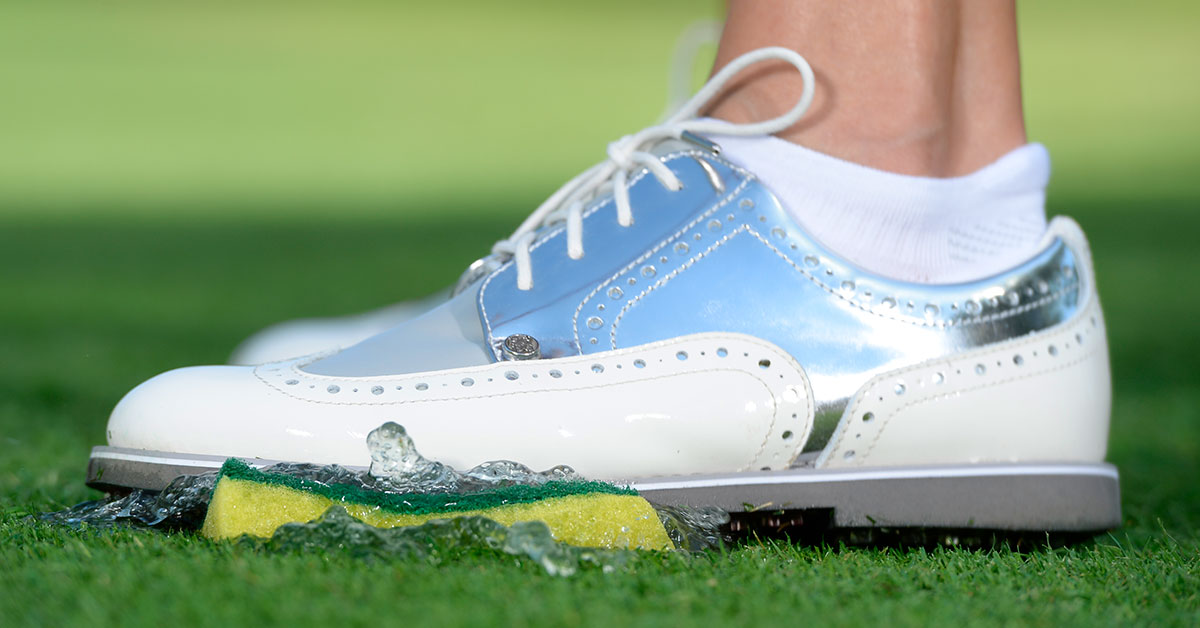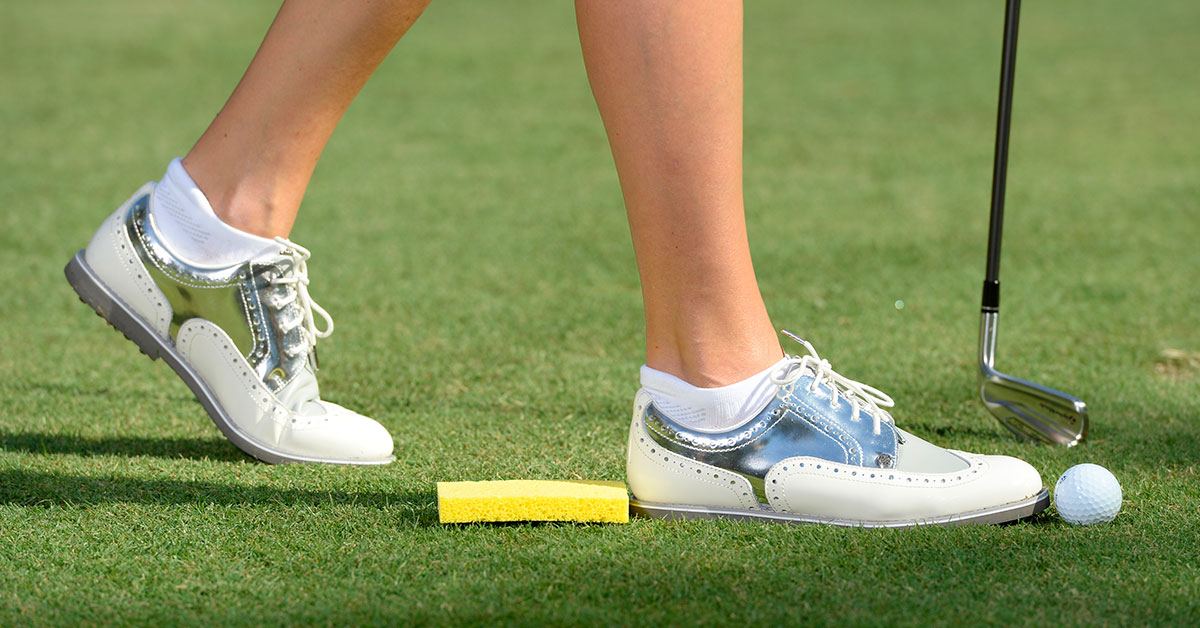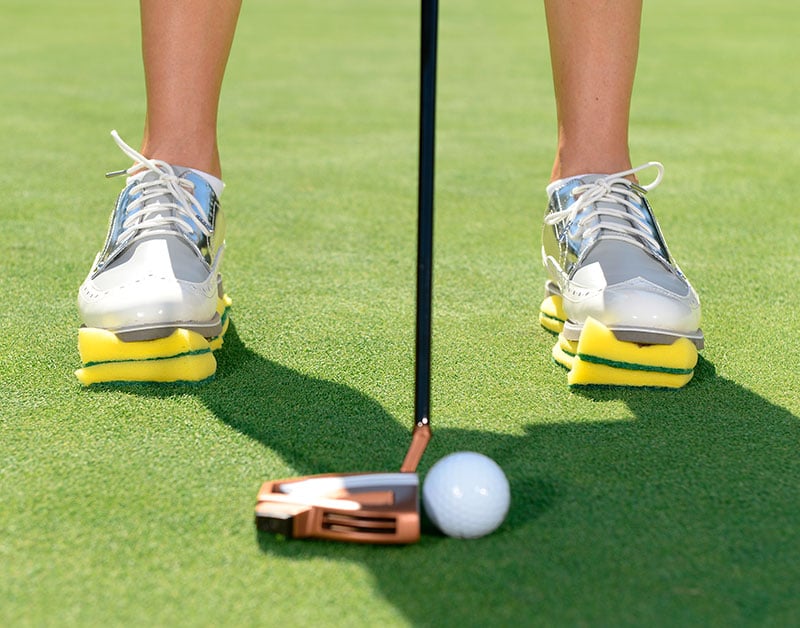Swing catalyst software and 3-D motion plates cost about $25,000. A TrackMan 4 launch monitor is $20,000. BodiTrak software and portable force plates are about $3,000. All of these game-improvement devices will definitely help you play better golf, but I’m guessing you’d like to know if there’s a low-cost alternative.
How about a 99-cent sponge?
 Buy a four-pack of these handy kitchen helpers, and you’re on your way to a better swing path, angle of attack, weight shift – even short game. That’s not hyperbole. I’ve been using sponges as golf training aids for more than a decade with great success. Why do they work? I’ve found my students don’t make improvements very well when they’re thinking about their swings. But when you give them something that makes them more aware of their body movements, like footwork and sequencing, it quickly cleans up faults. They’re sensing and reacting as opposed to thinking about where the club needs to go. For example, I’ve soaked this sponge and then squashed it with my left foot at the start of my downswing [inset above]. This reminds me to shift my weight into my front foot and use the ground as leverage to create a more powerful swing.
Buy a four-pack of these handy kitchen helpers, and you’re on your way to a better swing path, angle of attack, weight shift – even short game. That’s not hyperbole. I’ve been using sponges as golf training aids for more than a decade with great success. Why do they work? I’ve found my students don’t make improvements very well when they’re thinking about their swings. But when you give them something that makes them more aware of their body movements, like footwork and sequencing, it quickly cleans up faults. They’re sensing and reacting as opposed to thinking about where the club needs to go. For example, I’ve soaked this sponge and then squashed it with my left foot at the start of my downswing [inset above]. This reminds me to shift my weight into my front foot and use the ground as leverage to create a more powerful swing.
There are plenty of other ways you can use a sponge or sponges as training aids, and I’ll show you five more in this article. The best part is that you can store sponges in your bag and use them in the practice area without drawing attention. They’re portable, inexpensive, inconspicuous and effective.
“Focus on body movement, and the club will follow.”
– Tasha Browner Bohlig
attack from the proper angle
 To hit good iron shots, the angle of descent into the ball can’t be too steep or bottom out too early. To make sure that doesn’t happen, place a sponge about eight inches behind the ball on your target line. For me, the distance is roughly the length of my foot. Then hit shots trying not to strike the sponge. You want to hit the ball first and then take a divot. Note: don’t move the sponge too close to the ball, because your angle of attack will be too steep.
To hit good iron shots, the angle of descent into the ball can’t be too steep or bottom out too early. To make sure that doesn’t happen, place a sponge about eight inches behind the ball on your target line. For me, the distance is roughly the length of my foot. Then hit shots trying not to strike the sponge. You want to hit the ball first and then take a divot. Note: don’t move the sponge too close to the ball, because your angle of attack will be too steep.
 get off to a good start
get off to a good start
Some golfers have had success swinging the club on different planes from backswing to downswing – like the PGA Tour’s Matthew Wolff. But you might find keeping the club on the same plane makes it easier to consistently hit solid shots. You can establish a good swing plane by stuffing a sponge under your trail-side armpit (right for right-handers) when you address a ball and keeping it there as you start back. A good start helps produce a great finish.
load before you go
 Many amateurs rush through the backswing, failing to create and store energy before returning the club to the ball. This can throw your swing out of sync, and it’s a killer if you’re trying to maximise potential distance. To make sure you load properly, place a sponge under your trail foot and push down on it as you swing the club back. If you keep pushing until it’s time to start the downswing, you’ll know you’ve created and stored sufficient power.
Many amateurs rush through the backswing, failing to create and store energy before returning the club to the ball. This can throw your swing out of sync, and it’s a killer if you’re trying to maximise potential distance. To make sure you load properly, place a sponge under your trail foot and push down on it as you swing the club back. If you keep pushing until it’s time to start the downswing, you’ll know you’ve created and stored sufficient power.
putt with quiet legs
 The best putters minimise extraneous movement during the stroke to make sure they hit the ball with the face square to the line of putt. That’s why you’ll see virtually no activity in the lower body as the putter moves back and through. If you practise your stroke with two sponges stacked under each foot, you’ll be much more aware of what it feels like to keep your lower body quiet. You’ll start rolling it like a pro.
The best putters minimise extraneous movement during the stroke to make sure they hit the ball with the face square to the line of putt. That’s why you’ll see virtually no activity in the lower body as the putter moves back and through. If you practise your stroke with two sponges stacked under each foot, you’ll be much more aware of what it feels like to keep your lower body quiet. You’ll start rolling it like a pro.
chip off your front foot
 Pressing down on a sponge under your front foot is a great reminder to leave your weight forward throughout a chip shot. It gets you to swing down on the ball – the proper technique. You’ll catch it solid, and chip it close. That outcome is certainly worth 99 cents. Maybe even a whole dollar.
Pressing down on a sponge under your front foot is a great reminder to leave your weight forward throughout a chip shot. It gets you to swing down on the ball – the proper technique. You’ll catch it solid, and chip it close. That outcome is certainly worth 99 cents. Maybe even a whole dollar.
– Tasha Browner Bohlig is a Golf Digest Best Young Teacher. She is based at El Caballero Country Club in Tarzana, California. Tasha spoke with Ron Kaspriske



